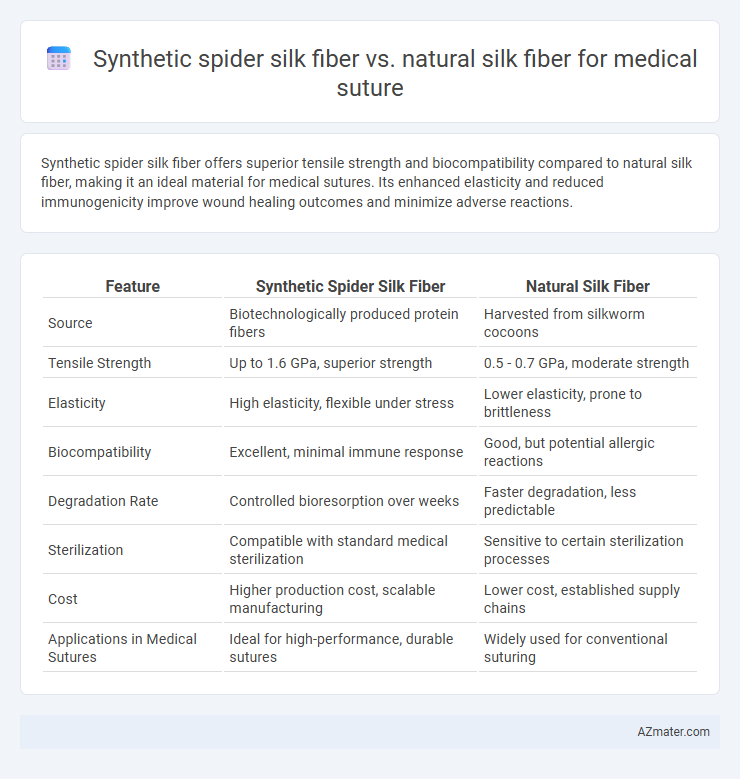Synthetic spider silk fiber offers superior tensile strength and biocompatibility compared to natural silk fiber, making it an ideal material for medical sutures. Its enhanced elasticity and reduced immunogenicity improve wound healing outcomes and minimize adverse reactions.
Table of Comparison
| Feature | Synthetic Spider Silk Fiber | Natural Silk Fiber |
|---|---|---|
| Source | Biotechnologically produced protein fibers | Harvested from silkworm cocoons |
| Tensile Strength | Up to 1.6 GPa, superior strength | 0.5 - 0.7 GPa, moderate strength |
| Elasticity | High elasticity, flexible under stress | Lower elasticity, prone to brittleness |
| Biocompatibility | Excellent, minimal immune response | Good, but potential allergic reactions |
| Degradation Rate | Controlled bioresorption over weeks | Faster degradation, less predictable |
| Sterilization | Compatible with standard medical sterilization | Sensitive to certain sterilization processes |
| Cost | Higher production cost, scalable manufacturing | Lower cost, established supply chains |
| Applications in Medical Sutures | Ideal for high-performance, durable sutures | Widely used for conventional suturing |
Introduction: Overview of Silk Fibers in Medical Sutures
Synthetic spider silk fiber offers enhanced biocompatibility and mechanical strength compared to natural silk fiber, making it a promising material for medical sutures. Natural silk fiber, traditionally derived from silkworms, has been widely used due to its flexibility and minimal tissue reaction, but it lacks the tensile strength and adjustable degradation rates found in synthetic counterparts. Advances in bioengineering allow synthetic spider silk fibers to mimic the natural protein structure while improving suture performance in wound healing and infection resistance.
Composition and Structural Differences
Synthetic spider silk fiber, composed primarily of engineered proteins mimicking spider silk's repetitive amino acid sequences, exhibits enhanced uniformity and tunable mechanical properties compared to natural silk fiber derived from Bombyx mori, which consists mainly of fibroin and sericin proteins. The synthetic variant's b-sheet crystal structures are more controllable, offering superior tensile strength and elasticity essential for medical sutures, whereas natural silk fibers have variable fibroin alignment and sericin coating affecting biodegradability and tissue compatibility. These compositional and structural distinctions enable synthetic spider silk sutures to provide improved biocompatibility, reduced immunogenicity, and tailored degradation rates critical for wound healing applications.
Mechanical Strength and Durability
Synthetic spider silk fiber exhibits superior mechanical strength and durability compared to natural silk fiber, making it highly suitable for medical sutures requiring high tensile resilience. Engineered to mimic the exceptional toughness and elasticity of natural spider silk, synthetic variants offer enhanced biocompatibility and consistent fiber quality, whereas natural silk fibers may degrade faster and exhibit variable mechanical properties. These attributes enable synthetic spider silk sutures to maintain wound closure effectively over extended healing periods, reducing the risk of suture failure and enhancing patient outcomes.
Biocompatibility and Tissue Response
Synthetic spider silk fiber demonstrates superior biocompatibility compared to natural silk fiber, minimizing immunogenic reactions and promoting faster wound healing in medical sutures. Its engineered molecular structure enhances tissue integration and reduces inflammation, leading to lower scar formation and improved patient outcomes. Natural silk fiber, while biocompatible, often triggers mild inflammatory responses due to sericin proteins, potentially affecting long-term tissue response.
Degradation and Absorption Rates
Synthetic spider silk fiber for medical sutures exhibits more controlled and tunable degradation rates compared to natural silk fiber, allowing for tailored absorption times suitable for different wound healing processes. Natural silk fiber tends to degrade slower and less predictably, which may prolong inflammation and hinder absorption in some cases. Synthetic variants also demonstrate enhanced biocompatibility and reduced immune response, optimizing tissue integration and minimizing adverse reactions during degradation.
Sterilization and Safety Considerations
Synthetic spider silk fiber offers enhanced sterilization resistance compared to natural silk fiber, maintaining structural integrity under high-temperature autoclave processes critical for medical sutures. Natural silk fibers are prone to degradation and loss of tensile strength after sterilization, increasing the risk of suture failure and infection. The biocompatibility and reduced immunogenicity of synthetic spider silk further improve safety profiles, minimizing inflammation and enhancing wound healing outcomes.
Cost and Scalability of Production
Synthetic spider silk fiber offers a cost-effective alternative to natural silk fiber for medical sutures due to its scalable production through recombinant DNA technology and microbial fermentation, enabling mass manufacturing without reliance on silkworm farms. This scalability reduces production bottlenecks and lowers the overall cost per unit, enhancing accessibility for healthcare applications. In contrast, natural silk fiber's harvesting process remains labor-intensive, limited by environmental factors and seasonal variability, resulting in higher costs and inconsistent supply.
Customization and Functionalization
Synthetic spider silk fiber offers superior customization and functionalization for medical sutures compared to natural silk fiber, enabling precise control over mechanical properties, biodegradability, and bioactivity. Genetic engineering and recombinant protein synthesis allow incorporation of antimicrobial peptides, growth factors, and tailored degradation rates to enhance wound healing and reduce infection risks. Natural silk fiber, while biocompatible and strong, lacks the tunable molecular structure necessary for these advanced, application-specific modifications in suture technology.
Clinical Performance and Case Studies
Synthetic spider silk fibers exhibit superior tensile strength, elasticity, and biocompatibility compared to natural silk fibers, making them highly effective for medical sutures in wound healing applications. Clinical case studies reveal that synthetic spider silk sutures reduce inflammation and infection rates while promoting faster tissue regeneration, outperforming traditional natural silk sutures in both acute and chronic wound management. Research published in journals like *Biomaterials* and *Advanced Healthcare Materials* confirms the enhanced clinical performance of synthetic spider silk, highlighting its potential to revolutionize suture technology.
Future Prospects in Medical Suture Applications
Synthetic spider silk fiber offers remarkable tensile strength, elasticity, and biocompatibility, making it a promising alternative to traditional natural silk fibers for medical sutures. Advances in bioengineering are enabling scalable production of synthetic spider silk with consistent quality, enhancing its potential for wound healing and tissue regeneration. Future prospects include tailored degradation rates and functionalization to improve antimicrobial properties, positioning synthetic spider silk as a superior solution for next-generation medical suture applications.

Infographic: Synthetic spider silk fiber vs Natural silk fiber for Medical suture
 azmater.com
azmater.com